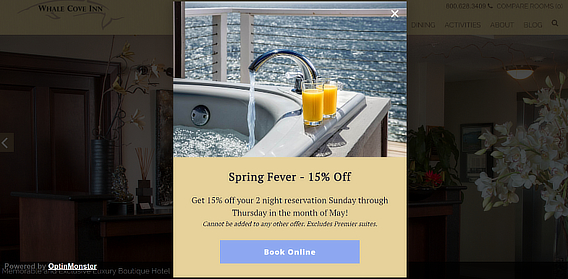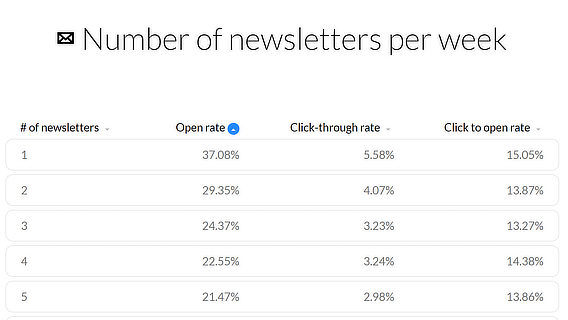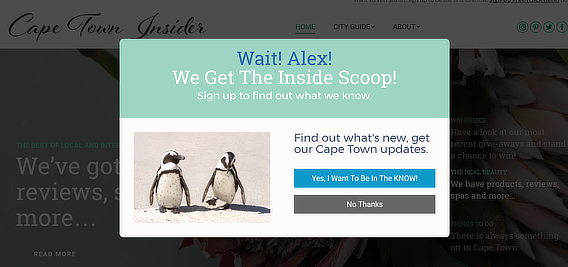How do you make your business stand out in an ultra-competitive, multi-million dollar industry? That’s a question that travel marketers have to wrestle with every day.
Travel is one of the world’s largest industries, expected to contribute US$16 trillion to the world economy by 2034, according to Statista.

With a lot of competition, and a large potential market, it’s essential to find effective ways to reach new customers, retain existing ones, and make your business stand out. One of the best ways to do that is with travel industry email marketing.
As our email marketing statistics roundup shows, more than 90% of American adults use email. Email has an ROI of $42 for every dollar spent, which is better than the ROI for both direct mail and social media.
This guide will show how marketers and travelers view travel industry email marketing. It’ll look at the increasing importance of mobile, and will give some email marketing tips and best practices for the travel industry.
- Benefits of Email Marketing for Travel Companies
- 6 Steps to Build and Manage Your Email List
- 5 Tips for Successful Travel Email Marketing
By the end, you’ll know how to nail travel industry email marketing so that more people use your travel business to book flights, reserve accommodation, rent cars, and do other travel-related tasks.
Benefits of Email Marketing for Travel Companies
1. Direct Engagement and Personalization
- Higher Engagement: Segmented email campaigns have a 14.31% higher open rate than non-segmented ones, making personalization crucial for travel brands. (Mailchimp)
- Building Relationships: Regular emails keep the brand top-of-mind and build loyalty with past travelers.
2. Cost-Effective with High ROI
- Proven ROI: For every $1 spent on email marketing, companies see an average return of $42. (DMA)
- Low Overhead: Compared to paid ads, email is a more affordable way to engage and convert leads.
3. Boosting Bookings with Targeted Promotions
- Increased Conversions: Nearly 60% of consumers say targeted promotions influence their purchase decisions. (HubSpot)
- Upselling Opportunities: Travel brands can cross-sell experiences or upgrades in emails, maximizing revenue from each booking.
4. Driving Loyalty and Retention
- Loyalty Programs: 83% of customers say that loyalty programs make them more likely to keep purchasing from a brand. (Accenture)
- Post-Trip Emails: Follow-up emails after a trip can prompt repeat bookings, reviews, or social media shares.
5. Inspiring Travel with Destination Content
- Increased Engagement: Destination emails with photos and tips inspire wanderlust, and emails with images get 42% higher click rates. (HubSpot)
- Content-Rich Newsletters: Sharing travel tips and trends keeps subscribers interested and engaged.
6. Collecting Customer Insights
- Data for Improvement: Tracking email engagement (like click-through rates) helps brands understand what resonates and refine future campaigns.
7. Strengthening Brand Awareness
- Building Trust: Consistent, informative emails build brand credibility, which can lead to higher open and click rates over time.
Now let’s get started with our travel industry email marketing tips. If you’re just starting your travel business, you’ll need to follow these six steps to build and manage your list. If you already have a list, skip to the best practices section below.
6 Steps to Build and Manage Your Email List
Step 1: Set Up Your Email List
The first step is to choose an email service provider. When choosing email marketing services for travel, check that there are plenty of travel-related email templates. If you want to send seasonal or niche emails (such as for beach or ski holidays, for example), you’ll need those.
If you’re using OptinMonster to collect emails (see the next step), you’ll be able to change the optin form templates to match your travel business, as in the example below.

Another important feature to look for when choosing your email service provider is analytics, so you can see how your travel marketing campaigns are doing.
Step 2: Collect Email Addresses
Any successful travel business has to get repeat business from existing customers, and attract new travelers. Your email list is an essential part of that process, so you need to keep it healthy.
A good starting point is to use an optin form on your travel website to get email newsletter signups. Make sure it’s visible, no matter where people are on your site.
It’s also useful to offer an incentive for signing up, like a coupon. See the example below:

When people make enquiries or reservations, that’s another good opportunity to ask them to sign up for your list. Be warned, you have to ask permission. Just because they give permission for you to email travel details, it doesn’t mean you can send anything you like.
Other travel email marketing techniques include running a contest and asking for an email address in exchange for an entry, or using an SMS “text to subscribe” campaign.

Want to learn how to improve your SMS marketing strategy? Check out this article on how to collect phone numbers on your website with popups.
You can also use OptinMonster to encourage people to sign up by targeting your optin offers. For example, you could deliver a lead magnet related to a particular destination by using page-level targeting.
You can use onsite retargeting to make an offer to returning visitors. And you can use exit intent to entice subscribers with a compelling offer just before they leave your website.

You can also promote your email signup form on your social media sites. Here’s how you add an optin form to Facebook.

Step 3: Choose Email Content
Many marketers struggle with content creation, so here are a few ideas for what to include in your travel marketing emails to get you started:
- Destination guides
- Travel tips and essential information
- Recommended destinations or trips
- Spotlights on attractions or events
- Information on holidays and festivals
- Reviews of both destinations and travel services
- Travel stories from other customers
- Polls and quizzes
- Cross-promotional offers (say, for hotels and car rental)
You can also include content from your blog (if you’re not blogging yet, here’s how you get started), favorable press coverage, and insider views of your travel company. And don’t forget about deals, discounts and loyalty offers. Litmus says that’s what most subscribers are looking for.
And, since you’ll be collecting customers’ date of birth as part of any reservation, you can add a yearly birthday email into your email marketing plan, to make each customer feel truly special.
Step 4: Get the Timing Right
Once you’ve decided what types of emails you want to send, figure out how often you will email your subscribers.
Avoid the temptation to email too often. Our research shows that around a quarter of people say they get too much email from travel brands. And Campaign Monitor‘s data shows that almost 44% of people want businesses to send less email.
The danger of sending too much email is that people will mark your emails as spam, unsubscribe or simply never open them. Those are all terrible options from a marketing viewpoint.
The latest email marketing benchmarks from GetResponse show that those who send one newsletter a week get the highest open and click-through rate, at 37.08% and 5.58% respectively, so that’s a good starting point for your own travel email marketing schedule.

However, this is an average across all industries, so you’ll need to work out the ideal frequency for your own audience.
Step 5: Create an Email Marketing Calendar
When you decide on email frequency, put your chosen emails into an email marketing calendar, so you know exactly what to send on which dates, and can see your email marketing plan at a glance. Hubspot has a useful email marketing calendar template you can use.
Start by putting in regular broadcasts, like emails that update customers about new articles on your blog, then add any promotions for the main holidays. Include any announcements that you know about, such as changes within the company. Finally, fill in the blanks with some of the email types suggested above.
Step 6: Send Your First Email
The first email you send subscribers is the most important, because it sets the tone for your relationship with them. For most businesses, that’s the welcome email, which has a 60% open rate.
A good welcome email will help you retain the subscribers you’ve already attracted, and make them feel good about being on your email list. Keep your welcome email short, relevant and valuable, and craft a killer email subject line to encourage people to open and read it.
This is a great place to ask subscribers to do one thing that gets them more involved with your company. It doesn’t need to be complicated; just reading a blog post or sharing a piece of content begins the bonding process. You’ll need to nail the call to action to be effective, though.
Next, let’s look at some practical strategies to improve your travel industry email marketing.
5 Tips for Successful Travel Email Marketing
1. Personalize your marketing
There may be billions of travelers worldwide, but each one wants to feel special. According to SmartInsights, 83% of millennials are happy for travel brands to track them so they can get personalized service. And 85% of travelers prefer customized, rather than generic, itineraries.
That’s why it’s important to tailor your travel industry email marketing promotions to people’s behavior and interests. The more relevant an offer is, the more likely it is that they’ll make a reservation.
One way to get personal with your customers is to use OptinMonster’s Smart Tags feature. That lets you use information you already have to personalize future interactions.
In the example below, this travel firm already has the person’s name, and has used that to get their attention for an offer.

And in this example, the store has used the person’s browsing history to make an offer based on what they were looking at. It’s easy to see how a travel site could use this to show offers related to particular destinations, experiences or types of travel.

2. Include videos
Did you know that, according to Econsultancy, 66% of travelers watch videos when researching a destination? That’s why it makes sense to include videos in your email marketing.
As our video marketing statistics roundup shows, marketers who use video increase brand awareness by 54% and get 66% more leads.
In addition to using videos in your emails, you can grab travelers’ attention early by embedding travel videos in your OptinMonster optin forms. In fact, we’ve got a couple of themes that are particularly suited to video embeds.

Here’s a tutorial on embedding video with OptinMonster, plus a guide for showing an optin after a video, if you prefer that approach.
3. Use their location
Consider adapting your email marketing campaigns, based on where travelers are located. It’s another useful type of personalization.
You can do that by using OptinMonster’s geolocation addon to target optins by location, and this same information can then form part of your campaigns.
Litmus also suggests including dynamic content in emails to pull in weather information for customers’ location or destination. Weather’s a factor for almost half of travelers from cold weather states, so sharing a little sunshine in your next email could be a big draw.
4. Make your offers urgent
Urgency is a tried and true marketing tactic, and nothing says “buy now” like a limited time offer. Digital Marketer used urgency to get a conversion rate of 8.45% for one optin campaign.
You can use this technique for your travel email marketing. We’re willing to bet that flash travel sales are one of the reasons some people make those unexpected travel purchases we mentioned earlier.
OptinMonster’s is the perfect way to do this. Just use a floating bar optin with the countdown theme, and set an end date for your sale. Here’s the full tutorial on creating a sales timer. We’ve had amazing results with this combo, so we know it works.
5. Detect their device
As mentioned earlier, mobile is where it’s at for travel email marketing, so make sure your optin campaigns are appropriate for the device subscribers are using.
OptinMonster’s page level targeting feature can also detect when users are on a tablet or phone and show the right campaign accordingly.
You can even use our InactivitySensor™ (which we like to call exit intent for mobile) to pop up a travel offer when it’s clear there’s no activity taking place.
Both these approaches can help boost mobile conversions. Here are some more tips for maximizing conversions from your mobile optins.
Finally, if you’re looking for more inspiration, take a leaf out of Expedia’s book. According to Tnooz, the company has gone mobile first, to match their customers’ preferences. They test everything on the small screen, and make sure it works there before rolling it out to the desktop version.
Now you know how to keep those bookings coming with travel industry email marketing, check out these simple ways to get even more email subscribers.
And follow us on Twitter and Facebook for more in-depth guides.










Add a Comment